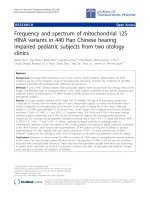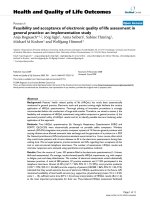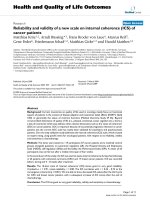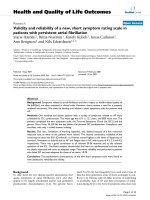báo cáo hóa học:" Theory and application of general linear image processing" pdf
Bạn đang xem bản rút gọn của tài liệu. Xem và tải ngay bản đầy đủ của tài liệu tại đây (78.6 KB, 6 trang )
This Provisional PDF corresponds to the article as it appeared upon acceptance. Fully formatted
PDF and full text (HTML) versions will be made available soon.
Theory and application of general linear image processing
EURASIP Journal on Advances in Signal Processing 2012,
2012:21 doi:10.1186/1687-6180-2012-21
Jean-Charles Pinoli ()
Guang Deng ()
Karen Panetta ()
ISSN 1687-6180
Article type Editorial
Submission date 4 April 2011
Acceptance date 7 February 2012
Publication date 7 February 2012
Article URL />This peer-reviewed article was published immediately upon acceptance. It can be downloaded,
printed and distributed freely for any purposes (see copyright notice below).
For information about publishing your research in EURASIP Journal on Advances in Signal
Processing go to
/>For information about other SpringerOpen publications go to
EURASIP Journal on Advances
in Signal Processing
© 2012 Pinoli et al. ; licensee Springer.
This is an open access article distributed under the terms of the Creative Commons Attribution License ( />which permits unrestricted use, distribution, and reproduction in any medium, provided the original work is properly cited.
Theory and application of general linear image processing
Jean-Charles Pinoli
*1
, Guang Deng
2
and Karen Panetta
3
1
Ecole Nationale Supérieure des Mines de Saint-Etienne, CIS-LPMG/CNRS,
Saint-Etienne Cedex 2, France
2
Department of Electronic Engineering, La Trobe University, Bundoora,
VIC 3086, Australia
3
Department of Electrical and Computer Engineering, Tufts University,
Medford, MA, USA
*Corresponding author:
Email addresses:
GD:
KP:
Image modeling in terms of physical/mathematical formation and the human
visual system plays an important role in developing new image processing
techniques. Parameters such as scale, orientation, texture, morphology, and
color must be taken into consideration in order to solve complicated image
processing problems efficiently. Although the classical linear image
processing (CLIP) approach has played a central role in image processing, it
is not necessarily the best and even the right choice. General linear image
processing (GLIP) approaches based on different image modeling techniques
have been studied to overcome some of the problems associated with CLIP.
Indeed, using general linear algebra, it is possible to develop entirely new
general linear operators and transforms. It is even possible to define entirely
new general linear operations (addition, scalar multiplication, convolution,
etc.) in order to describe how images are combined, amplified, transformed,
analyzed, compared, and measured.
There have been 24 articles submitted to this special issue. After two rounds
of peer review process, five articles have been selected.
In the first article, the authors propose a generalization of the logarithmic
image processing (LIP) model by introducing several parameters into the
model. The LIP model, which is based on a physical image formation model,
appears as a special case of the proposed model when these parameters are
set to specific values. New generalized operations are defined. The
application of the proposed model is demonstrated by solving image fusion
problems in a multi-resolution framework.
In the second article, the authors present a blind watermarking scheme in
which the watermark is embedded in the wave atom transform domain. The
wave atom transform, which is a relatively new mathematical representation
of images, has been demonstrated to produce sharper frequency localization
than filter bank-based wavelet packets. The authors show that using the wave
atom representation the proposed watermarking algorithm is robust against
various attacks.
In the third article, the authors present methods for meeting the challenges of
using mobile projectors ubiquitously in the same manner as mobile phones.
A vision-based projector–camera (i.e., pro–cam) system is often the choice
for researchers in this field because it allows object augmentation
everywhere without relying on separate tracking hardware. Furthermore, a
user can interact directly with the projection. However, there are challenges
encountered when making a pro–cam system aware of its surrounding
objects, while still retaining ubiquity. One issue is that ubiquitous projection
implies use in an unknown environment that has not been prepared. The
second problem, called “projective interference”, can lead to false detections
of the environment and object. The authors present solutions using
nonintrusive projection, which can ensure correct vision-based analysis. The
external appearances of the environment and object are hardly changed by
the overlaid projected content. Finally, an unsupervised visual detector is
used to guarantee robustness of the detection regardless of lighting
variations. Several image processing algorithms are applied in the
framework including image warping using perspective transformation, color
conversion using the nearest-neighbor search algorithm, and multiscale
visual detection.
A persistent issue in image processing is quantifying the improvement or
measuring the visual quality resulting from the output image generated by an
image processing algorithm. The fourth article deals with utilizing and
deriving new quantitative metrics that leverage on the well-known structural
similarity (SSIM) indexes. The authors show that SSIM index, which is used
in image processing to assess the similarity between an image representation
and an original reference image, can be formulated as a locally quadratic
distortion measure. In addition, the authors derive the high-resolution SSIM-
Rate-Distortion Function (RDF) and provide a simple method to numerically
compute an approximation of the SSIM–RDF of real images.
Finally, the transmission of images requires quality compression algorithms
that maintain the most pertinent image details. The fifth article presents a
new block-based image compression scheme based on generation of fixed
block sets, called classified energy blocks and classified pattern blocks. The
method shows promise for a high compression ratio and acceptable image
quality in terms of PSNR levels even at low bit rates. The encoding
parameters are the block scaling coefficient and the index numbers of energy
and pattern blocks (IE, IP) determined for each block of the input images. In
the decoding process, all these parameters are sent through the
communication channel from the transmitter part to the receiver part and the
classified energy and pattern blocks (CEPB) associated with the index
numbers are pulled from the CEPBs. Then, the blocks of the input image are
reconstructed in the receiver part using the presented mathematical model. In
this study, in order to remove the blocking effect and improve the PSNR
levels, a post-processing filter is used on the reconstructed images and the
PSNR levels are improved in the range of 0.5–1 dB. The speed of the
algorithm and the compression ratio are also increased by adjusting the size
of the CEPB using an efficient clustering algorithm.
Acknowledgments
As guest editors, we would like to express our sincere gratitude to all those
who have contributed to this special issue, and the reviewers who have
provided many critical comments and constructive suggestions to the
manuscripts submitted. We are sorry that many of the articles submitted are
not able to be included in this special issue due to the time constraints and
the amount of modification required. We do hope that this special issue will
boost the interest of GLIP within the image processing and computer vision
community.
Jean-Charles Pinoli
Guang Deng
Karen Panetta









